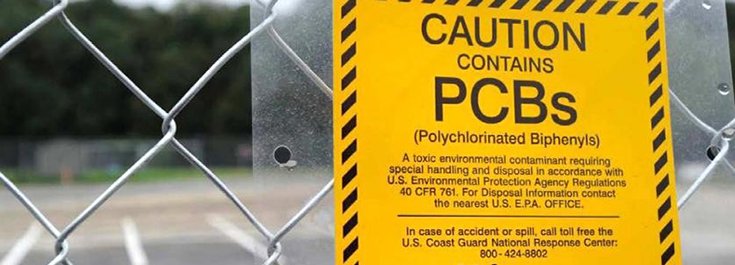Washington State Sues Monsanto over PCB Pollution

On December 8, Washington Attorney General Bob Ferguson announced a lawsuit against Monsanto over toxic PCB chemicals polluting “every waterway in the state.” It marks the first time a state has ever sued the biotech giant. [1]
The environmental lawsuit seeks damages and cleanup costs associated with the company’s production of the industrial chemicals. In a statement, Ferguson said that Monsanto produced the polychlorinated biphenyls (PCBs) “for decades while hiding what they knew about the toxic chemicals’ harm to human health and the environment.”
He went on to say:
“It is time to hold the sole U.S. manufacturer of PCBs accountable for the significant harm they have caused to our state. Monsanto produced PCBs for decades while hiding what they knew about the toxic chemicals’ harm to human health and the environment.” [2]
The Attorney General pointed to internal company documents which show Monsanto was aware of the dangers PCBs posed for decades. One internal memo dating back to 1937 said testing on animals showed “systemic toxic effects” from prolonged exposure by inhaling PCB fumes or ingestion. A company committee for Monsanto said in a 1969 internal memo:
“There is too much customer/market need and selfishly too much Monsanto profit to go out.”

Another committee memo said:
“There is little probability that any action that can be taken will prevent the growing incrimination of specific polychlorinated biphenyls … as nearly global environmental contaminants leading to contamination of human food (particularly fish), the killing of some marine species (shrimp), and the possible extinction of several species of fish eating birds.”
By comparison, Monsanto told officials around the country that the chemicals were safe. In a letter to New Jersey’s Department of Conservation that year, Monsanto wrote:
“Based on available data, manufacturing and use experience, we do not believe PCBs to be seriously toxic.”
The lawsuit seeks damages on several grounds, including product liability for Monsanto’s alleged failure to warn about the health and environmental risks posed by PCBs; negligence; and trespass, for injuring the state’s natural resources.
Monsanto spokesman Scott S. Partridge said in a statement that the:
“…case is experimental because it seeks to target a product manufacturer for selling a lawful and useful chemical four to eight decades ago that was applied by the U.S. government, Washington State, local cities, and industries into many products to make them safer. PCBs have not been produced in the U.S. for four decades, and Washington is now pursuing a case on a contingency fee basis that departs from settled law both in Washington and across the country. Most of the prior cases filed by the same contingency fee lawyers have been dismissed, and Monsanto believes this case similarly lacks merit.”
A Little Bit About PCBs

The National Oceanic and Atmospheric Administration’s (NOAA) website states that PCBs “were banned in the U.S. in 1979 amid suggestions that the chemicals could have unintended impacts on human and environmental health.”
Prior to the ban, PCBs were used for microscope oils, electrical insulators, capacitors, and appliances such as televisions, or refrigerators. These industrial products were also sprayed on dirt roads to prevent dust from spreading.
NOAA goes on to say:
“PCBs can degrade or breakdown in the environment, but the process greatly depends on the chemical makeup of the PCBs. The degrading process also depends on where the PCBs are in the environment. Typically, PCBs are either broken down in the environment by sunlight or by microorganisms. Sunlight plays an important role in the breakdown of PCBs when they are in the air, shallow water, or surface soils. Microorganisms, such as bacteria, algae, or fungi, biodegrade PCBs when found in soil or sediments.”
According to the World Health Organization (WHO), PCBs have been shown to cause a variety of health problems, including:
- Cancer
- Altered liver function
- Impairment of the immune system, the developing nervous system, the endocrine system, and reproductive functions
A History of Lawsuits
Individual cities in Washington State have already filed lawsuits of their own against Monsanto. Spokane did so in August, 2015. The city vowed to spend $300 million to keep PCBs and other pollutants from entering the Spokane River in coming years, all of which were the direct result of Monsanto dumping them in paint, ink, hydraulic fluid, and industrial sealant form.
The lawsuit accused Monsanto of selling chemicals for decades that it knew were harmful to human health and the environment.

In January, 2016, Seattle became the 6th major U.S. city to sue Monsanto after untold amounts of PCBs contaminated the city’s waterways over the course of several decades. The situation became so dire that the Health Department warned locals that due to contamination of Lower Duwamish Waterway, there was no safe amount of local fish or shellfish to eat.

Citizens have also sued Monsanto. In June, 3 people who alleged that PCBs made by Monsanto, Solutia, Pharmacia, and Pfizer caused their cancers were awarded $46.5 million by a St. Louis Circuit Court jury. All of the plaintiffs were diagnosed with non-Hodgkin lymphoma. Some of them died and their claims were made by surviving relatives.
Sources:
[1] Reuters
Washington Department of Ecology
EcoWatch (main image source)
